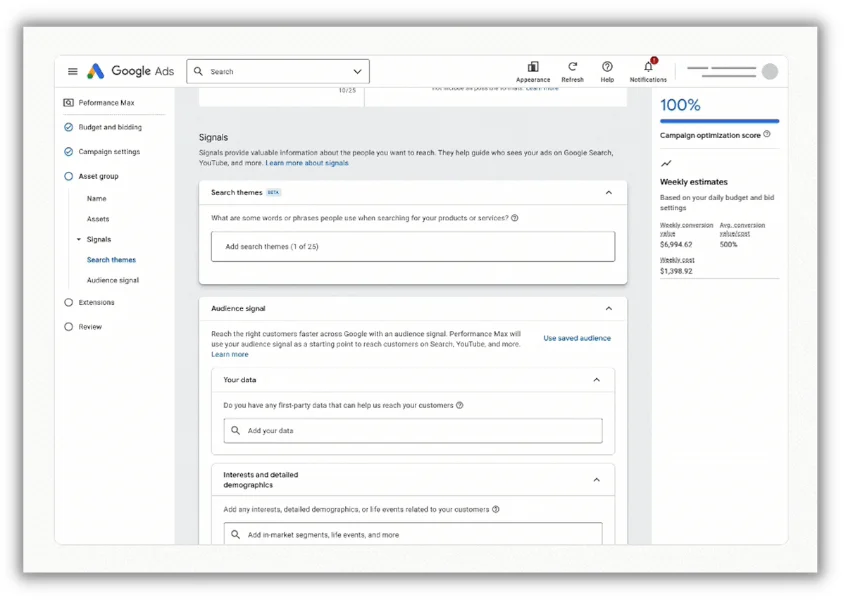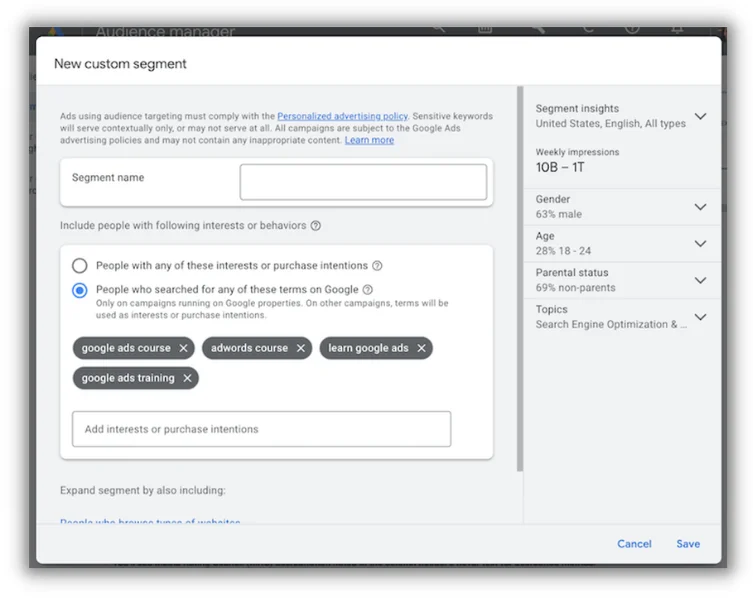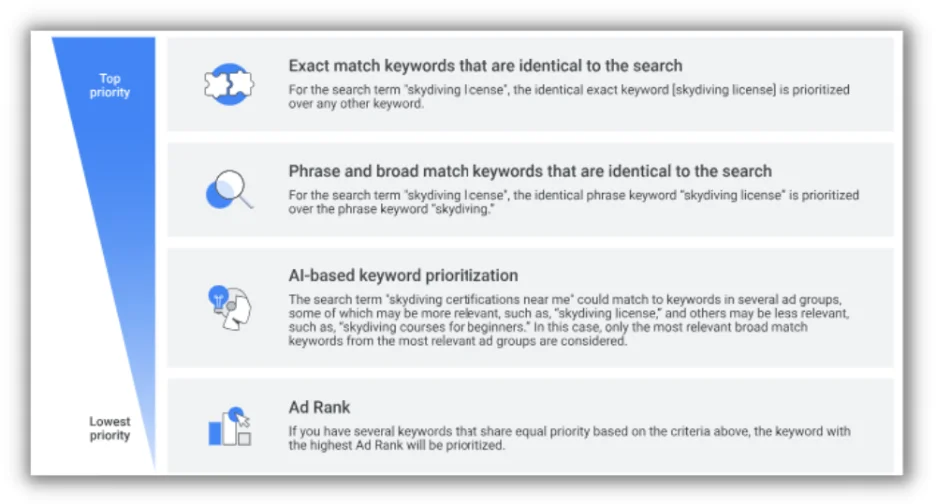PPC
Everything You Need to Know

When Google first introduced its Performance Max campaigns, it set off with a goal to make advertising across all of its properties (search, display, video, Discover, Gmail, and Maps) simple to manage within one campaign type.
Getting started with Performance Max campaigns is easy. Optimizing Performance Max campaigns? Well, that can be much more difficult.
Luckily, Google recently released a new beta feature for Performance Max campaigns called “search themes” designed to help advertisers better target their ads with a similar keyword-inspired approach that most advertisers are used to. In this article, we’re covering what search themes are, how to create them, and how to use them the right way.
Table of contents
What are search themes for Performance Max campaigns?
Google’s fully automated campaign type allows you to control very little. You can improve your different ad assets, website, product feed, and even provide audience signals to better target your Performance Max campaigns–but that’s still very lacking to the rest of Google Ad’s targeting options. Especially for most of us who are used to running search campaigns with robust keyword targeting options–running search ads through Performance Max campaigns can be a frustrating experience.
Search themes are a new feature that allows advertisers to provide some additional context and signals to Google to help target their Performance Max campaigns. Advertisers can provide search themes to Google to share how they expect their customers to search for their products or services.
With this additional context, Google can consider these search themes as new signals to target audiences based on their search behavior. Google may use these search themes to better refine their Performance Max campaign targets, or to reach new relevant placements on the SERP and beyond.

Search themes is an optional feature in Performance Max campaigns. However, we’ve seen time and time again that Performance Max campaigns perform the best when they’re given better signals, so I’d encourage you to provide Google with at least a few search themes to give Google enough signals to optimize your campaigns with. Advertisers can provide up to 25 search themes per asset group.
🛑 Worried you’re wasting spend in Google Ads? Find out with a free, instant audit >> Google Ads Performance Grader
Search themes are set to replace custom segments based on search intent
Within Google’s most recent announcement introducing Search themes, Google also shares that they’ll be ending support for custom segments based on past search activity within Performance Max campaigns in early 2024. These audience segments will automatically be upgraded to Search Themes.
Previously known as “Custom Intent” audiences, these audiences used very similar signals to the new Search themes, effectively targeting people based on their past searches on Google. Since this audience signal is so similar to Google’s new “search themes” beta, the automatic upgrade in 2024 is unlikely to negatively impact campaign performance. Hopefully, it streamlines workflows and makes signal management easier for advertisers.


Custom segments based on previous search activities will continue to function uninterrupted in other campaign types, including search campaigns. Additionally, all other custom segments based on other attributes (affinities, interests, apps, URLs, and demographics) will continue to exist in Performance Max campaigns and serve as valuable audience signals for Google’s ongoing optimization.
How do I create search themes in my Performance Max campaigns?
Search themes is a new feature in beta and may not currently be available to all advertisers, however, Google is expected to release it to more advertisers throughout the rest of the year.
- To add search themes to your Performance Max campaigns, simply:
Select a Performance Max campaign. - Select an Asset group. Each asset group can have different audience signals and search themes.
- Next to your ad assets in your Asset group, you’ll notice a card for “Signals.” Select the pencil icon to edit your signals.


- Here, you’ll see the new Search Themes beta. Advertisers can add up to 25 unique search themes per asset group to help improve the signals of their Performance Max campaign. Each search theme must be shorter than 80 characters in length.


- Be sure to scroll to the bottom of the page and save your changes to your Asset group signals!
Search themes can also be edited or removed at any time from this menu. Once changed or removed, Google will no longer use that signal when targeting its ads to an audience.
But removing a search theme isn’t like removing a keyword or adding a negative keyword in a search campaign–Google may continue to serve ads on similar search queries if it believes it’s relevant to users. However, Search themes will still respect any brand exclusions or account-level negative keywords that you’ve implemented. If you want to prevent your Performance Max campaigns from serving for irrelevant and unwanted traffic–you’ll still want to use those tools!
⚡️ Is your Google Ads account set up for success? Download now >> The Last Guide to Google Ads Account Structure You’ll Ever Need
How will search themes in Performance Max campaigns affect my search ads?
Performance Max campaigns and traditional search campaigns are both eligible to serve ads on the Google SERP and search partner engines. Advertisers who are running both Performance Max campaigns and search campaigns will often run into issues where both campaign types are targeting the same searches and risk serving different ad experiences to the same searches or struggle to manage the two campaigns synchronously. Using search themes in Performance Max may ease some of those issues for advertisers.
In these issues where multiple campaigns or ad groups are eligible to serve an ad to a searcher, Google prioritizes exact match keywords that are identical to the search above all others. Google’s new Search themes are treated as a lower priority, equal to that of phrase and broad match keywords.


Your exact match keywords in your search campaigns will also take priority over your Performance Max campaigns–so they’re still a must-have for advertisers now.
Best practices for using search themes in Performance Max campaigns
While nearly all additional data and context will help these Performance Max campaigns continue to improve, advertisers can make the most of search themes in their accounts by following a few tips.
1. Use search themes to provide information missing from your landing pages
If you’ve just launched a new product or website, your landing page may not include every single feature, benefit, use, value, and detail that a searcher might consider–and that’s okay! In fact, a clean and simplified landing page may help more people convert on your site.
If Google can’t find that context from your landing page–fret not. Liberally use search themes in your Performance Max campaigns to provide those extra signals to Google so it best understands what your audience may be looking for and can optimize its placements accordingly.
2. Be direct—especially when using ulterior brand messaging
What does direct mean? Well, consider the well-known fast-casual restaurant Hooters. If you were to just read their website or its descriptions, you might mistakenly describe their business as a chicken wings restaurant. But we all know that there are a few missing keywords in that description that serve their core value prop and distinguish them from similar competitors.
There’s nothing shameful about having hidden benefits that you don’t expressly convey within your ads or on your website. Maybe your hotel welcomes all but is known best for catering to families, tourists, a religious community, foreign-speaking nationals, or people recovering from a nearby medical procedure, or maybe it has a history of being haunted. You might not want to explicitly write some of that on your website or within your ads—but if someone is specifically looking for a paranormal vacation a Sabbath-friendly accommodation, or a sanctuary nearby their treatment, advertisers can use search themes to better signal their ads within a Performance Max campaign.
3. Maximize your varied and unique search themes
Advertisers are allowed up to 25 search themes within each asset group. Generally, the more signals you can provide to Google, the better your Performance Max campaigns will perform. However, quantity isn’t the only factor in quality.
Treat your search themes similar to how you’d treat broad match keywords in your search campaigns–make sure that they aren’t effectively the same signal. For example, the search themes “car” and “automobile” will reach the exact same audience and won’t improve performance incrementally.
4. Consider competitor terms as search themes
Especially if you’re a new brand on the market–this will help Google more quickly understand who your prospects are currently searching for. Google allows bidding on your competitors’ keywords (in many cases) within your search campaigns and includes your competitor’s brands and product names as search themes. Before implementing this strategy, however, make sure that you understand any local laws or regulations about how you can advertise on competitor brands and trademarks.
5. Use traditional search campaigns alongside your Performance Max campaigns
Search themes are a powerful signal to add to your Performance Max campaigns. Even though your Performance Max campaigns will automatically target the search network, don’t neglect the importance of your search campaigns on their own.
Use search themes within your Performance Max campaigns to find new placements and scale incremental traffic and continue to apply that found insight to your search campaigns. As you build your search campaigns, be sure to incorporate exact match keywords so that they take priority over your Performance Max search theme signals, and you can continue to target, optimize, and refine your newfound traffic.
Use search themes the right way in Performance Max campaigns
Google’s new search themes beta will help advertisers share their human expertise and provide better signals to their machine learning powered Performance Max campaigns. Search themes gives you a little more control over your Performance Max campaigns, making them more effective and tailored for your audience.












